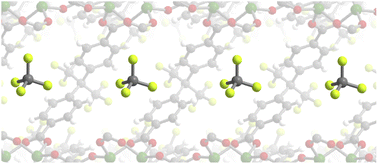Selective adsorption of fluorinated super greenhouse gases within a metal–organic framework with dynamic corrugated ultramicropores†
Abstract
Perfluorocompound (PFC) gases play vital roles in microelectronics processing. Requirements for ultra-high purities traditionally necessitate use of virgin sources and thereby hinder the capture, purification, and reuse of these costly gases. Most importantly, gaseous PFCs are incredibly potent greenhouse gases with atmospheric lifetimes on the order of 103–104 years, and thus any environmental emissions have an outsized and prolonged impact on our climate. The development of sorbents that can capture PFC gases from industrial waste streams has lagged substantially behind the progress made over the last decade in capturing CO2 from both point emission sources and directly from air. Herein, we show that the metal–organic framework Zn(fba) (fba2− = 4,4′-(hexafluoroisopropylidene)bis-benzoate) displays an equilibrium selectivity for CF4 adsorption over N2 that surpasses those of all water-stable sorbents that have been reported for this separation. Selective adsorption of both CHF3 and CH4 over N2 is also evident, demonstrating a general preference for tetrahedral C1 gases. This selectivity is enabled by adsorption within narrow corrugated channels lined with ligand-based aryl rings, a site within this material that has not previously been realized as being accessible to guests. Analyses of adsorption kinetics and X-ray diffraction data are used to characterize sorption and diffusion of small adsorbates within these channels and strongly implicate rotation of the linker aryl rings as a gate that modulates transport of the C1 gases through a crystallite. Multi-component breakthrough measurements demonstrate that Zn(fba) is able to resolve mixtures of CF4 and N2 under flow-through conditions. Taken together, this work illuminates the dynamic structure of Zn(fba), and also points toward general design principles that can enable large CF4 selectivities in sorbents with more favorable kinetic profiles.

- This article is part of the themed collections: #MyFirstChemSci 2024 and 2024 Journal of Materials Chemistry Lectureship runners-up: Maxx Arguilla and Phillip Milner


 Please wait while we load your content...
Please wait while we load your content...